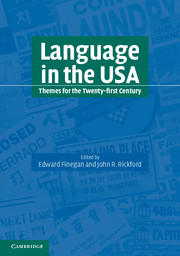Book contents
- Frontmatter
- Contents
- List of figures
- List of tables
- List of contributors
- Acknowledgments
- Foreword
- Editors' preface
- Part 1 American English
- Part 2 Other language varieties
- Part 3 The sociolinguistic situation
- 15 Language ideology and language prejudice
- 16 Ebonics and its controversy
- 17 Language planning, language policy, and the English-Only Movement
- 18 Language in education
- 19 Adolescent language
- 20 Slang
- 21 Hip Hop Nation Language
- 22 Language, gender, and sexuality
- 23 Linguistic identity and community in American literature
- 24 The language of doctors and patients
- 25 The language of cyberspace
- 26 Language attitudes to speech
- Index
23 - Linguistic identity and community in American literature
Published online by Cambridge University Press: 05 June 2012
- Frontmatter
- Contents
- List of figures
- List of tables
- List of contributors
- Acknowledgments
- Foreword
- Editors' preface
- Part 1 American English
- Part 2 Other language varieties
- Part 3 The sociolinguistic situation
- 15 Language ideology and language prejudice
- 16 Ebonics and its controversy
- 17 Language planning, language policy, and the English-Only Movement
- 18 Language in education
- 19 Adolescent language
- 20 Slang
- 21 Hip Hop Nation Language
- 22 Language, gender, and sexuality
- 23 Linguistic identity and community in American literature
- 24 The language of doctors and patients
- 25 The language of cyberspace
- 26 Language attitudes to speech
- Index
Summary
Editors' introduction
Of the characters in a literary text, this chapter asks how we know who we are reading – how is a character's social identity represented and conveyed in a literary work? To answer the question, James Peterson proposes four analytical tools: the author's identity; stereotypes; situational contexts; and orthographic practices. With a warning against the dangers of essentialism, he notes that critically acclaimed representations of ethnicity, gender, and sexual orientation have typically been produced by authors with first-hand knowledge of those identities – from Ralph Ellison and James Baldwin to Toni Morrison and Alice Walker; from Sherman Alexie to Amy Tan, and from Richard Rodriguez to Sandra Cisneros. Similar to author identity in its transparency is situational context – the setting of the activities of fictional characters – whether living on Indian reservations or playing the dozens on the streets of Detroit. A third device is stereotypical representation, which writers may use to upend the oppressive effects of stereotyping, subverting the negative import of those effects. Lastly – and most obviously linguistic – is orthography, the characteristics of spelling, punctuation, and other devices of written linguistic representation by which authors endeavor to indicate social identity.
In this chapter you will see how Peterson applies these analytical tools to the representation of identity in the works of Native American writer Sherman Alexie, Latin novelists Esmeralda Santiago and Piri Thomas, and African American authors from Charles Chesnutt in the nineteenth century to Ellison, Richard Wright, and Zora Neale Hurston, among others, in the twentieth century.
- Type
- Chapter
- Information
- Language in the USAThemes for the Twenty-first Century, pp. 430 - 444Publisher: Cambridge University PressPrint publication year: 2004
- 2
- Cited by



